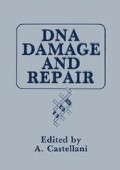Abstract
The study of the lethal and mutagenic effects of partially-reduced oxygen species such as hydrogen peroxide and superoxide is important for several reasons. Many chemotherapeutic agents generate activated oxygen species during their metabolism1, and these may have an important role in the toxicity of these drugs. Furthermore, these same species have been proposed to have an important role in tumor promotion2 and in the inflammatory response3. Finally, studies with activated oxygen species can provide insights into the cellular effects of γ-radiation4,5, although there is only partial similarity between these damaging agents. The present paper summarizes recent collaborative studies among our laboratories on the mechanisms of hydrogen peroxide-induced lethality in both mammalian and bacterial cells, and compares these results with those obtained in other laboratories.
Access this chapter
Tax calculation will be finalised at checkout
Purchases are for personal use only
Preview
Unable to display preview. Download preview PDF.
References
V.V. Subrahmanyam, L.G. McGirr, and P.J. O’Brien, Oxygen activation during drug metabolism. Pharmacol. Ther. 33:63 (1987).
P. Cerutti, Prooxidant states and tumor promotion. Science (Wash. DC), 22/: 375 (1985).
J.C. Fantone and P.A. Ward, Role of oxygen-derived free radicals and metabolites in leukocyte-dependent inflammatory reactions. Am. J. Pathol. 115:398 (1982).
J.F. Ward, W.F. Blakely, and E.I. Joner, Mammalian cells are not killed by DNA single-strand breaks caused by hydroxyl radicals from hydrogen peroxide. Radiat. Res. 103:383 (1985).
J.F. Ward, J.W. Evans, C.L. Limoli, and P.M. Calbro-Jones, Radiation and hydrogen peroxide induced free radical damage to DNA. Br. J. Cancer Suppl. VIII, 55:105 (1987).
L.H. Thompson, K.W. Brookman, L.E. Dillehay, A.V. Carrano, J.A. Mazrimas, C.L. Mooney, and J.L. Minkler, A CHO-cell strain having hypersensitivity to mutagens, a defect in DNA strand-break repair and an extraordinary baseline frequency of sister chromatid exchange. Mutat. Res. 95:427 (1982).
Cantoni, D. Murray, and R.E. Meyn, Effect of 3-aminobenzamide on DNA strand break rejoining and cytotoxicity in CHO cells treated with hydrogen peroxide. Biochim. Biophys. Acta 867:135 (1986).
Cantoni, D. Murray, and R.E. Meyn, Induction and repair of DNA single-strand breaks in EM9 mutant CHO cells treated with hydrogen peroxide. Chem. Biol. Interactions 63:29 (1987).
Cantoni, D. Murray, P. Sestili, F. Cattabeni, V. Stocchi, P. Cerutti and R.E. Meyn, Hydrogen peroxide insult in cultured mammalian cells: Relationship between DNA single-strand breakage and poly(ADP)ribosylation. Submitted.
A.C. Mello Filho and R. Meneghini, In vivo formation of single-strand breaks in DNA by hydrogen peroxide is mediated by the Haber-Weiss reaction. Biochim. Biophys. Acta 781:56 (1984).
A.C. Mello Filho, M.E. Hoffmann, and R. Meneghini, Cell killing and DNA damage by hydrogen peroxide are mediated by intracellular iron. Biochem. J. 218:273 (1984).
H.C. Birnboim and M. Kanabus-Kaminska, The production of DNA strand breaks in human leukocytes by superoxide anion may involve a metabolic process. Proc. Natl. Acad. Sci. USA 82:6820 (1985).
C. Richter, B. Frei and P. Cerutti, Mobilization of mitochondrial Ca2+ by hydroperoxy-eicosatetraenoic acid. Biochem. Biophys. Res. Comm. 143:609 (1987).
T. Ochi and P. Cerutti, Clastogenic action of hydroperoxy-5,8,11, 13-icosatetraenoic acids on the mouse embryo fibroblasts C3H1OT 1/2. Proc. Natl. Acad. Sci. USA 84: 990 (1987).
I U. Schraufstatter, D.B. Hinshaw, P.A. Hyslop, R.G. Spragg, and C.G. Cochrane, Oxidant injury of cells. DNA strand breaks activate polyadenosine diphosphate-ribose polymerase and lead to depletion of nicotinamide adenine dinucleotide. J. Clin. Invest. 77:1312 (1986).
I.U. Schraufstatter, P.A. Hyslop, D.B. Hinshaw, R.G. Spragg, L:A. Sklar, and C.G. C.chrane, Hydrogen peroxide-induced injury of cells and its prevention by inhibitors of poly (ADP-ribose) polymerase. Proc. Natl. Acad. Sci. USA 83: 4908 (1986).
J.A. Imlay and S. Linn, Bimodal pattern of killing of DNA-repairdefective or anoxically grown Escherichia coli by hydrogen peroxide. J. Bacteriol. 166:519 (1986).
G. Brandi, P. Sestili, M.A. Pedrini, L. Salvaggio, F. Cattabeni, and O. Cantoni, The effect of temperature or anoxia in Escherichia coli killing induced by hydrogen peroxide. Mutat. Res., 190: 237 (1987).
G. Brandi, F. Cattabeni, A. Albano, and O. Cantoni, Role of hydroxyl radicals in Escherichia coli killing by hydrogen peroxide. Submitted.
G. Brandi, G.F. Schiavano, M. Magnani, A. Albano, F. Cattabeni, and 0. Cantoni, Superoxide anions are required for the inactivation of Escherichia coli induced by high concentrations of hydrogen peroxide. Submitted.
A. Carlioz and D. Touati, Isolaiton of superoxide dismutase mutants in Escherichia coli: is superoxide dismutase necessary for aerobic life ? EMBO J. 5: 623 (1986).
J.A. Imlay and S. Linn, Mutagenesis and stress responses induced in Escherichia coli by hydrogen peroxide. J. Bacteriol. 169:2967 (1987).
Author information
Authors and Affiliations
Editor information
Editors and Affiliations
Rights and permissions
Copyright information
© 1989 Springer Science+Business Media New York
About this chapter
Cite this chapter
Cantoni, O., Brandi, G., Cerutti, P., Meyn, R.E., Murray, D. (1989). Mechanisms of Hydrogen Peroxide Cytotoxicity in Mammalian and Bacterial Cells. In: Castellani, A. (eds) DNA Damage and Repair. Springer, Boston, MA. https://doi.org/10.1007/978-1-4757-5016-4_29
Download citation
DOI: https://doi.org/10.1007/978-1-4757-5016-4_29
Publisher Name: Springer, Boston, MA
Print ISBN: 978-1-4757-5018-8
Online ISBN: 978-1-4757-5016-4
eBook Packages: Springer Book Archive

